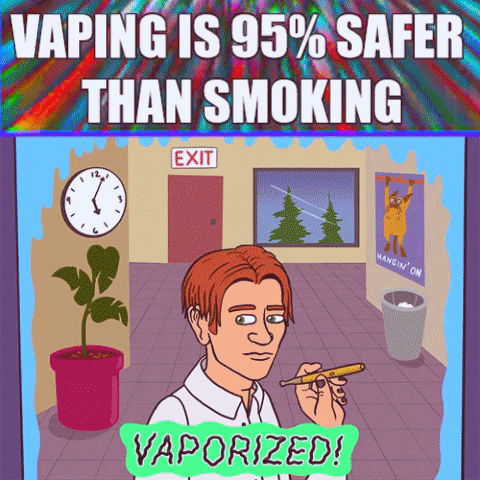Just where did the vaping is 95% safer fact originate?

Well to find out let's go all the way back to 2015 where Public Health England had officially declared that “vaping is at least 95% safer than smoking.” A statement which the health organisation again confirmed in 2018, when it launched its new campaign titled; Public Health England’s Health Harms campaign.
The real start of this story is in 2014 when the Public Health England ordered a report aiming to study the effect of vaping on health. One year later, the 2015 report, written by John Britton and Ilze Bogdanovica from the UK Center for Tobacco and Alcohol Studies of the University of Nottingham, was presented to the organization. After inspecting the report Public Health England officially declared “the hazard associated with use of EC products currently on the market is likely to be extremely low, and certainly much lower than smoking and the health risks of passive exposure to electronic cigarette vapor are likely to be extremely low.”
Public Health England had also proceeded to release its own report on the inquiry: “These conclusions tally with a review by an international team of experts,which estimated the risks of vaping at less than 5% of the risks of smoking, and a comprehensive review of relevant literature by another international team which concluded that EC aerosol can contain some of the toxicants present in tobacco smoke, but at levels which are much lower. Long-term health effects of EC use are unknown but compared with cigarettes, EC are likely to be much less, if at all, harmful to users or bystanders.” EC in this finding is of course short for Electronic Cigarettes.
To break down and begin to understand just exactly where “at least 95 % safer” fact originated from, we need to take a look at another study conducted by an international expert panel convened by the Independent Scientific Committee on Drugs. Those researchers developed a multi-criteria decision analysis model of the relative importance of different types of harm related to the use of products containing nicotine.
After analyzing twelve products, fourteen harm criteria were defined, seven of which present harm to users and the other seven present harm to bystanders. The study authors weighted the scoring on each criterion for their average harm worldwide using a scale where 100 is defined as the most harmful product on a given criterion, and a score of zero is no harm overall.
The results were as follows: Cigarettes were split between 33 harmful to others and 67 harmful to users, totaling 100 on the previously defined scale. Small cigars were rated 67 harmful to users and 0 to others, interestingly.
Pipes, cigars, water pipes, smokeless unrefined, smokeless refined, and snus all ranged from 20 down to 5 with vapes being right at the very end of that edge landing on that estimated total of 5 rating of only user harm.
With Electronic Nicotine Delivery Systems obtaining a score of less than 5, meaning that the devices carry approximately 5% the risks of smoking. Which brings us to the now common statement of fact: “vaping is at least 95% safer than smoking.” Public Health England then concluded that the dangers associated with vaping to be extremely low in comparison to those associated with smoking.
In order to ensure that the findings are accurate, the UK government had also looked into the claims that there were dangerous compounds found in vapor, such as formaldehydes and acrolein. The first research looking into these emissions was a Japanese study first mentioned in 2014 by the Japan Times, according to which “during the tests of various electronic cigarettes, one was responsible for emissions of formaldehydes 10 times higher than tobacco cigarettes”.
Luckily for us Public Health England had explained that these toxic emissions only occurred when eLiquid was intentionally overheated. Unfortunately for us that was the time mainstream media had picked up on the "dangers of vaping" and the rumor was widely spread that vaping contains formaldehydes, regardless of the very fact that the study in question was never been published because of Public Health England's observation into the flawed execution of the study.
Replicating this flawed Japanese study in January 2015, a similar study was released that found that the rate of formaldehyde found in the aerosol was “5 to 15 times higher than a tobacco cigarette, when the personal vaporizer was used at maximum power, for 3 to 4 seconds" which intentionally replicated the undesired vaping experience commonly known as a dry hit.
Again in response Public Health England had explained that these results were obtained by testing on smoking machines, and no human vaper would take such long puffs at such power. More importantly when vapers experience a dry hit, they instinctively spit out and recoil to the vapor because of the unbearable taste. Although the presence of these toxic substances is undeniable in the event that eLiquid overheats, no vaper would ever inhale them on purpose.
Yet unfortunately again the old truism holds strong: A lie will get halfway around the world before the truth even gets out of bed. The vaping hysteria had more fuel to it's fire and the myth that there is commonly formaldehyde people are vaping in eLiquids to this day still lingers.
We now of course know that a vaporizer produces higher levels of formaldehyde than smoking, but only when used under poor and unrealistic conditions. In normal use, the vapor produced by an electronic cigarette contains “absent or negligible” levels of toxic compounds.
There you have it! The history of the 95% claim and the all hard work Public Health England has put in to ensure that they aren't just blowing smoke when they state that stat. What do you think about all this? Are the scientists nuts or are they doing good science? Will the contemporary vaping hysteria ever face the constantly growing mountain of evidence and be crushed out by it?





